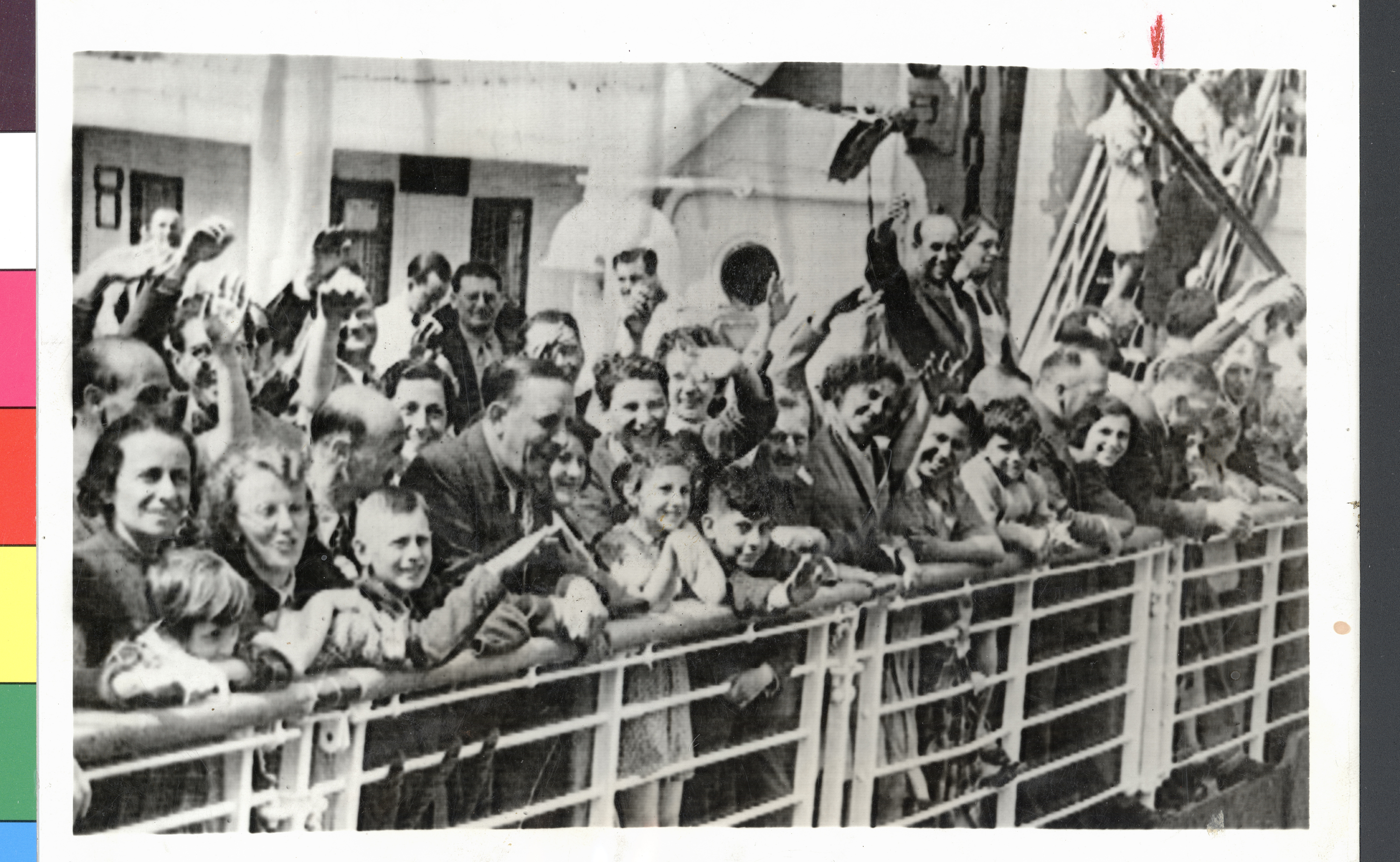
Seeking Refuge
Months after the rise of Adolf Hitler and the Third Reich in 1933, the lives and livelihood of Jews in Germany were put in peril. Hundreds of discriminatory laws were issued in Germany that directly targeted Jewish citizens. Jews were, for instance, forced from the civil service, disbarred as lawyers, and dismissed as teachers, while quotas restricted the number of Jewish children allowed in schools. In 1935, the Nuremberg Laws revoked Jewish Germans’ citizenship and voting rights, leaving them no protection under the law as state-condoned violence against Jews escalated.
The world was aware that the situation in Germany was getting worse for the Jews, especially following reports of Kristallnacht (9–10 November 1938). The “night of broken glass,” as it was called, was a night of violent riots in Nazi Germany and Austria in which Jewish establishments were targeted and destroyed. Hundreds of synagogues were burned to the ground and at least 91 Jews were killed (although this was the number reported by German officials, recent scholarship suggests that hundreds died). Approximately 30,000 Jewish men were arrested and sent to prison camps in Dachau, Buchenwald, and Sachsenhausen — which would later become death camps. This and many similar events, forced hundreds of thousands of German Jews to seek refuge before the Second World War (see Refugees).
Voyage of MS St. Louis
MS St. Louis departed Hamburg, Germany, on 13 May 1939. The 937 refugees on board the luxury liner were desperate to leave a dangerous situation in Europe. Nearly all of the passengers were Jewish, mostly German citizens, with some eastern Europeans aboard, as well as Spanish and Cuban passengers. Some were officially “stateless” and many had lost their businesses and homes. Others had been freed from Dachau and Buchenwald on the condition they promptly leave Germany.
MS St. Louis was bound for Cuba, a country for which many of its passengers held landing visas. They had also completed the necessary paperwork to enter the United States and anticipated a stopover in Cuba before gaining entry to the United States.
The ship was held in port when it arrived at Havana on 27 May. Only 29 passengers were allowed to disembark; 28 purchased new documents in port, and one was hospitalized in Havana (another passenger had died during the voyage). Increased anti-Semitism, the corrupt sale of landing certificates, and recent changes to immigration regulations in Cuba kept the ship and its passengers in port for days.
But Captain Gustav Schröder refused to return the remaining 907 passengers to Nazi Germany. He appealed to the Cuban authorities to no avail. After his pleas were rejected, the ship was ordered out of Cuban waters, which it left on 2 June. The captain sailed to the Florida coastline, in hopes that America would offer to take the refugees. Instead, St. Louis was met and trailed by the Coast Guard. A committee representing the passengers wrote to President Franklin D. Roosevelt, as did many other groups and prominent Americans who were sympathetic to the passengers’ plight. American officials argued that the refugees aboard the ship had to wait their turn in a long line of asylum seekers. The president refused to accept the refugees, and St. Louis sailed north, bound for Europe.
Word of the plight of those aboard the ship had reached Canada. In Toronto, 41 prominent citizens, including clergyman and historian George Wrong, petitioned Prime Minister William Lyon Mackenzie King on 7 June to provide sanctuary for the refugees. While away on official business, King asked undersecretary of state for external affairs Oscar Skelton to consult on the matter with Minister of Justice Ernest Lapointe, and Frederick Blair, director of the Government of Canada’s Immigration Branch. Lapointe was “emphatically opposed” to admitting the refugees, and Blair argued that they did not qualify under current immigration laws — laws he had created. “No country,” according to Blair, “could open its doors wide enough to take in the hundreds of thousands of Jewish people who want to leave Europe: the line must be drawn somewhere.”
Though the ship was just two days from Halifax Harbour, it continued on its course for Europe. There are no records that suggest Captain Schröder lobbied the Canadian government during this time.
On 17 June, St. Louis docked in Antwerp, Belgium, and from there, the passengers dispersed: 214 went to Belgium, 224 to France, 181 to Netherlands, and 288 to the United Kingdom. Over the course of the Second World War, many of these states fell under Nazi control, putting the refugees back in harm’s way. Though many survived the atrocities of the war, a staggering number were sent to concentration camps where 254 of those passengers perished (see Canada and the Holocaust).
“None is too many”
From 1919, the federal Cabinet could prohibit immigrants to Canada based on their race, nationality, occupation and class. For many years, prospective immigrants were listed in order of descending preference, with British and Americans at the top and Jews, Asians, Roma people, and Black persons at the bottom. According to the 1931 census, 155,766 Canadians identified as Jewish — representing 1.5 per cent of the population
By 1931, Canada was reeling from the Great Depression. In response to growing levels of unemployment, the federal government tightened its already severe restrictions on immigration (see Immigration Policy). An average 16,280 immigrants were admitted to Canada each year between 1931 and 1938. Although certain kinds of immigrants were admitted by Cabinet — farmers and the wealthy predominantly — very small numbers of Jews were permitted. At the time, religious intolerance and anti-Semitism were common in Canadian society and even in its cultural and political leaders — right up to Prime Minister William Lyon Mackenzie King:
We must nevertheless seek to keep this part of the Continent free from unrest and from too great an intermixture of foreign strains of blood, as much the same thing as lies at the basis of the Oriental problem. I fear we would have riots if we agreed to a policy that admitted numbers of Jews.
[Excerpt from King’s private diary, 29 March 1938.]
Between 1933 and 1945, Canada admitted fewer than 5,000 Jewish refugees. During that same period, countries hit harder by the Depression admitted far more. According to Irving Abella in None Is Too Many, the United States admitted more than 200,000, Palestine 125,000 and Britain 70,000. All told, Canada admitted the lowest number of refugees among developed nations. The government’s stance on Jewish refugees has often been conflated with the words of a senior Canadian official when asked how many Jews would be admitted to Canada at the end of the Second World War. His reply was, “None is too many.” (See also Prejudice and Discrimination; Racism).
Significance
The Canadian government’s refusal to admit Jewish refugees in need of sanctuary in the years leading to and during the Second World War is one example of Canada’s history of selective and often discriminatory immigration practices (see also Komagata Maru, Chinese Head Tax, Restrictions to Japanese Immigration). Though it was known that Jews faced persecution, false imprisonment, and outright violence in Nazi-controlled regions of Europe before the Second World War, their fate was unknown. And while the government’s reaction to the crisis was demonstrably linked to its anti-Semitic sentiments, it could not have foreseen the carnage ahead.
Legacy
On 5 November 2000, members of the Canadian clergy gathered to apologize to 25 surviving St. Louis passengers. Baptist minister Doug Blair was among the clergymen who apologized. He is the great nephew of Frederick Blair, who was in charge of Canadian immigration in 1939.
On 20 January 2011, a memorial sculpture commemorating the St. Louis refugees was unveiled at the Canadian Museum of Immigration at Pier 21 in Halifax, where the ship would probably have landed. Called The Wheel of Conscience, the statue is the work of American architect Daniel Libeskind and graphic designer David Berman. The kinetic steel sculpture is comprised of four gears. The first, labelled hatred, turns increasingly larger gears labelled racism, xenophobia and anti-Semitism. The names of all the passengers who were on the ship are etched on the back of the sculpture.

 Share on Facebook
Share on Facebook Share on X
Share on X Share by Email
Share by Email Share on Google Classroom
Share on Google Classroom


